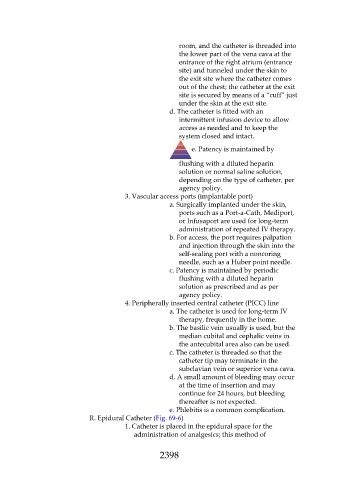Page 2398 - Saunders Comprehensive Review For NCLEX-RN
P. 2398
room, and the catheter is threaded into
the lower part of the vena cava at the
entrance of the right atrium (entrance
site) and tunneled under the skin to
the exit site where the catheter comes
out of the chest; the catheter at the exit
site is secured by means of a “cuff” just
under the skin at the exit site.
d. The catheter is fitted with an
intermittent infusion device to allow
access as needed and to keep the
system closed and intact.
e. Patency is maintained by
flushing with a diluted heparin
solution or normal saline solution,
depending on the type of catheter, per
agency policy.
3. Vascular access ports (implantable port)
a. Surgically implanted under the skin,
ports such as a Port-a-Cath, Mediport,
or Infusaport are used for long-term
administration of repeated IV therapy.
b. For access, the port requires palpation
and injection through the skin into the
self-sealing port with a noncoring
needle, such as a Huber point needle.
c. Patency is maintained by periodic
flushing with a diluted heparin
solution as prescribed and as per
agency policy.
4. Peripherally inserted central catheter (PICC) line
a. The catheter is used for long-term IV
therapy, frequently in the home.
b. The basilic vein usually is used, but the
median cubital and cephalic veins in
the antecubital area also can be used.
c. The catheter is threaded so that the
catheter tip may terminate in the
subclavian vein or superior vena cava.
d. A small amount of bleeding may occur
at the time of insertion and may
continue for 24 hours, but bleeding
thereafter is not expected.
e. Phlebitis is a common complication.
R. Epidural Catheter (Fig. 69-6)
1. Catheter is placed in the epidural space for the
administration of analgesics; this method of
2398

